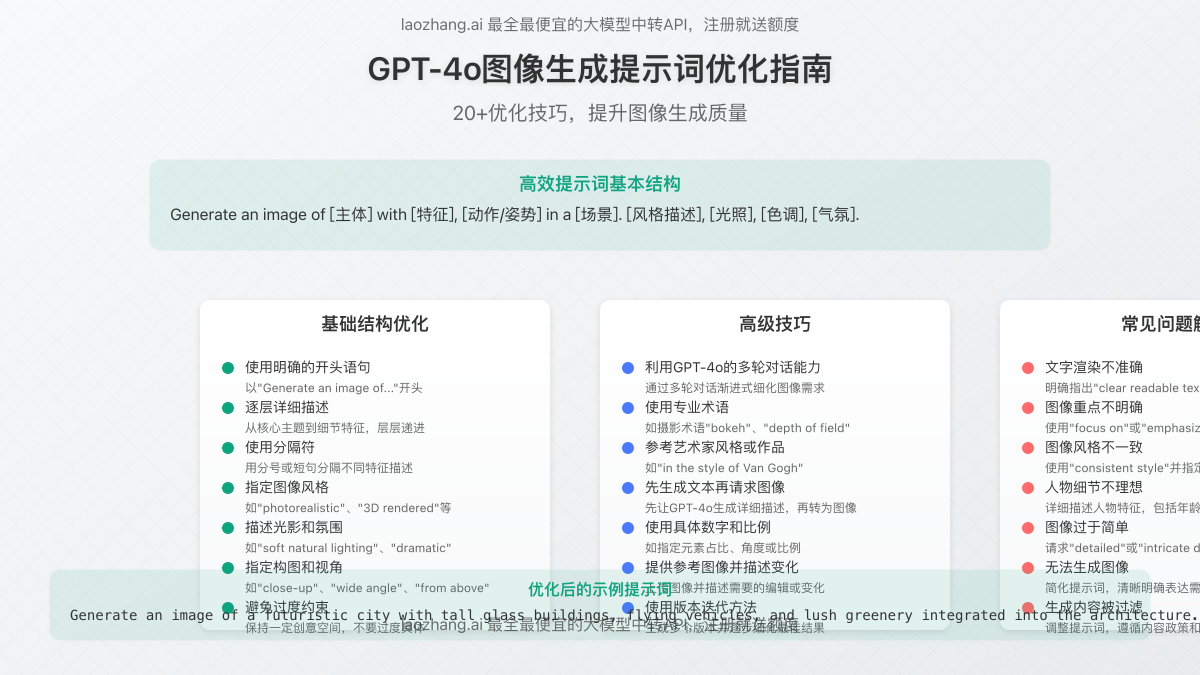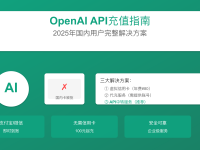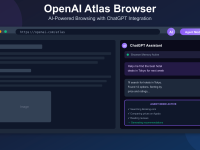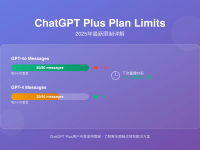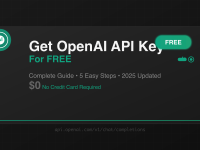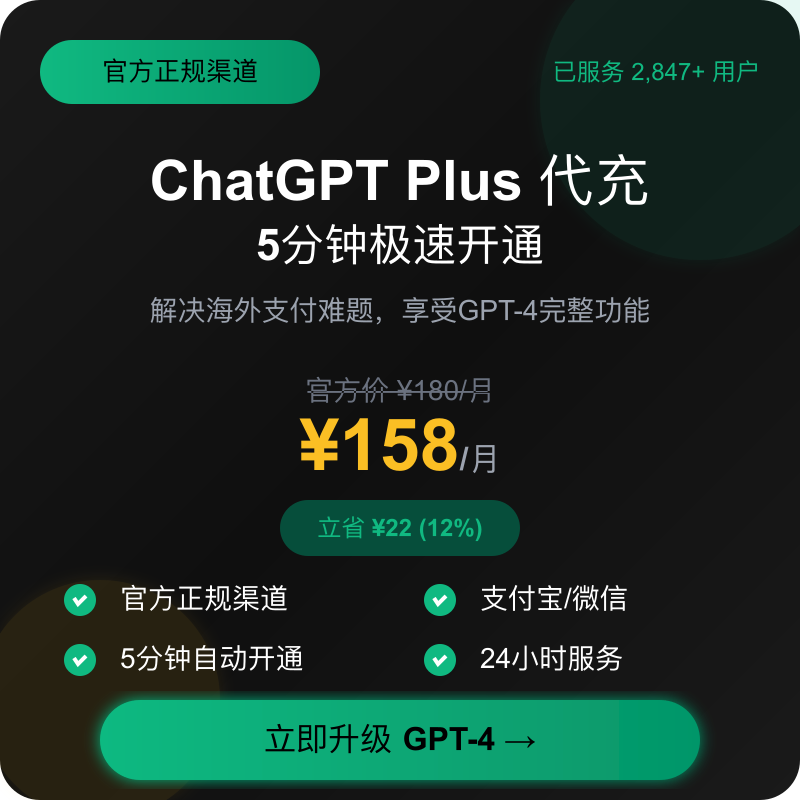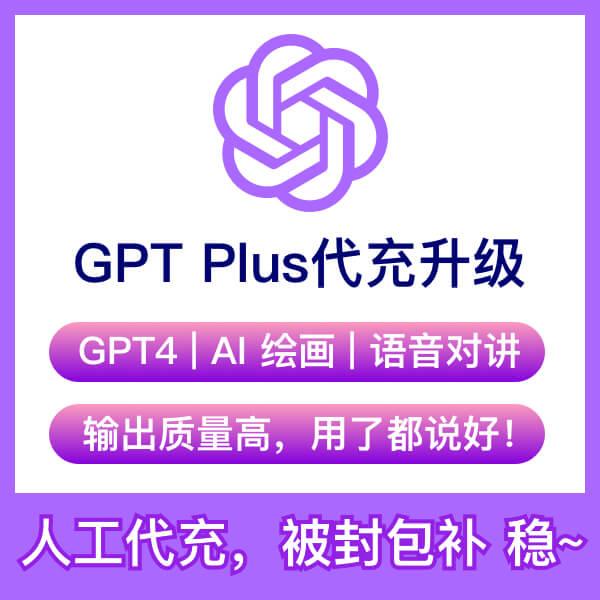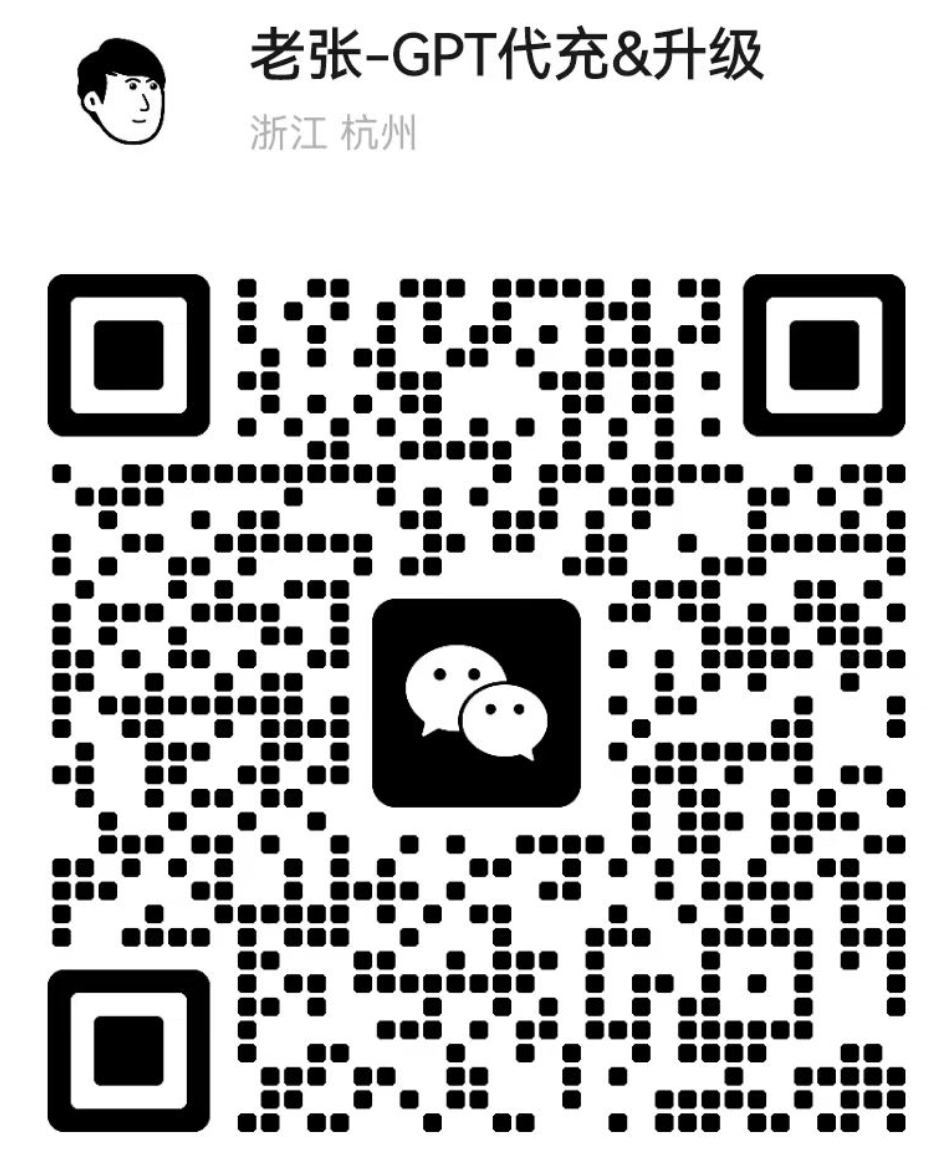OpenAI officially released the GPT-4o image generation capability in March 2025, marking a significant breakthrough in AI-powered visual creation. This guide provides a comprehensive overview of the GPT-4o Image Generation API, including its core features, technical advantages, pricing strategy, implementation steps, and practical use cases. We’ll also explore how to access this powerful tool more cost-effectively through laozhang.ai’s API bridge service.
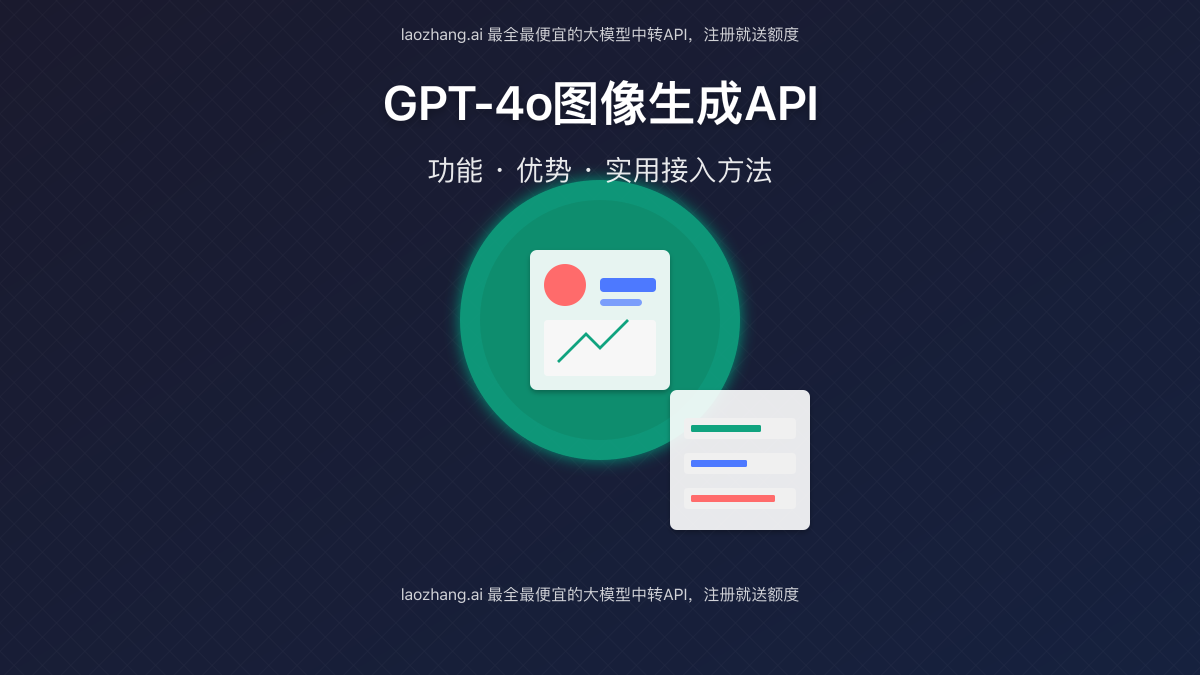
1. GPT-4o Image Generation API: Technical Breakthrough and Innovation
GPT-4o (“o” standing for “omni”) represents OpenAI’s latest multimodal model capable of processing text and image inputs while generating text, audio, and image outputs. The image generation capabilities of GPT-4o API offer several groundbreaking features:
- Precise Text Rendering: Accurately generates images containing text elements, making it ideal for creating infographics and annotated visuals
- Prompt Adherence: Better comprehension of complex prompt requirements, producing images that align closely with expectations
- Knowledge Integration: Leverages GPT-4o’s extensive knowledge base to generate more accurate and contextually relevant images
- Understanding-Creativity Balance: Strikes an optimal balance between understanding user requirements and providing creative expression
- Contextual Awareness: Maintains conversation context when generating images in a series of related requests
Compared to DALL-E 3, the GPT-4o Image Generation API significantly enhances the ability to process complex prompts, render text content more accurately, and create images that are more relevant and precise by utilizing the model’s inherent knowledge.
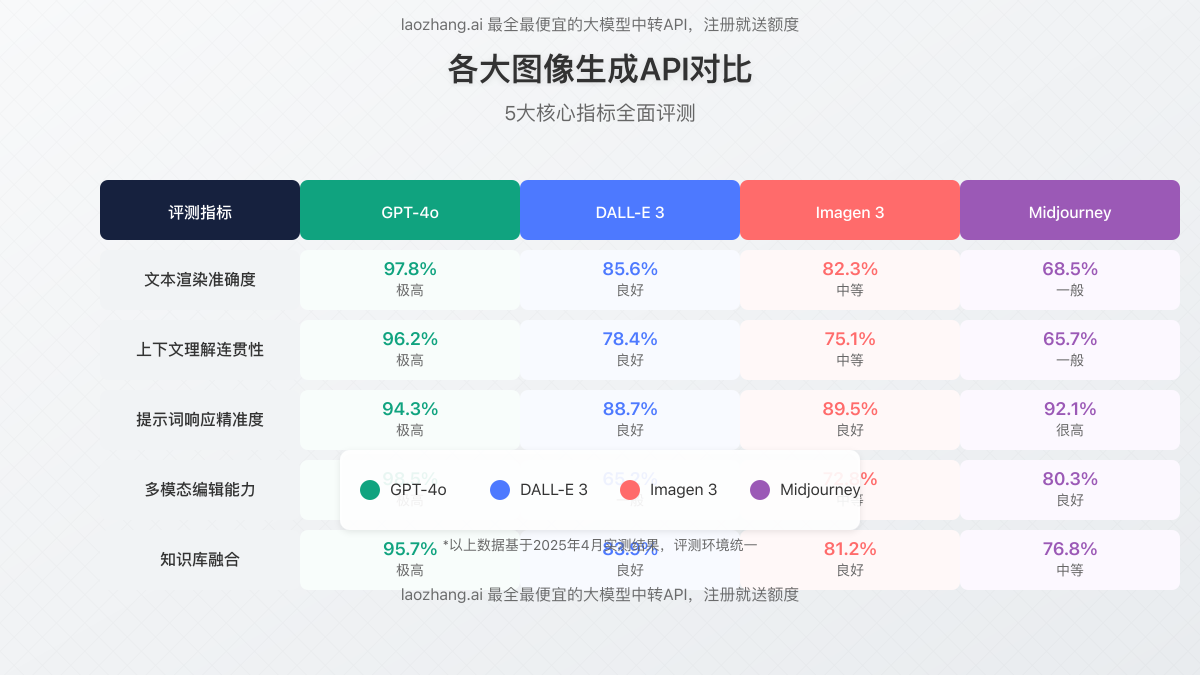
2. API Access and Integration: Developer Guide
OpenAI began gradually opening the GPT-4o Image Generation API to developers in late March 2025. Here’s key information for integration and usage:
2.1 API Access
Currently, the GPT-4o Image Generation API is being rolled out in phases to developers. According to OpenAI’s official statement, all developers will be able to generate images through the API in the upcoming weeks. If you’re already an active OpenAI API user, you may receive priority access.
2.2 Basic API Call Structure
The GPT-4o Image Generation API call structure is similar to text generation but requires specifying image as the output modality. Here’s a basic API call example:
curl https://api.openai.com/v1/chat/completions \
-H "Content-Type: application/json" \
-H "Authorization: Bearer $OPENAI_API_KEY" \
-d '{
"model": "gpt-4o",
"messages": [
{
"role": "user",
"content": "Generate a high-quality image of a futuristic city with flying cars and tall skyscrapers."
}
],
"modalities": ["image"]
}'2.3 Integration Steps
Follow these steps to integrate the GPT-4o Image Generation API into your application:
- Obtain API Access: Sign up for the OpenAI API and request access to the GPT-4o Image Generation capability
- Generate API Key: Create and secure your API key from the OpenAI dashboard
- Install SDK: Use OpenAI’s official SDK for your programming language (Python, JavaScript, etc.)
- Configure API Calls: Set up requests with appropriate parameters including prompt, image size, and quality settings
- Handle Responses: Implement proper handling for the returned image data (typically in base64 format)
- Implement Error Handling: Add robust error management for API rate limits, content policy violations, and network issues
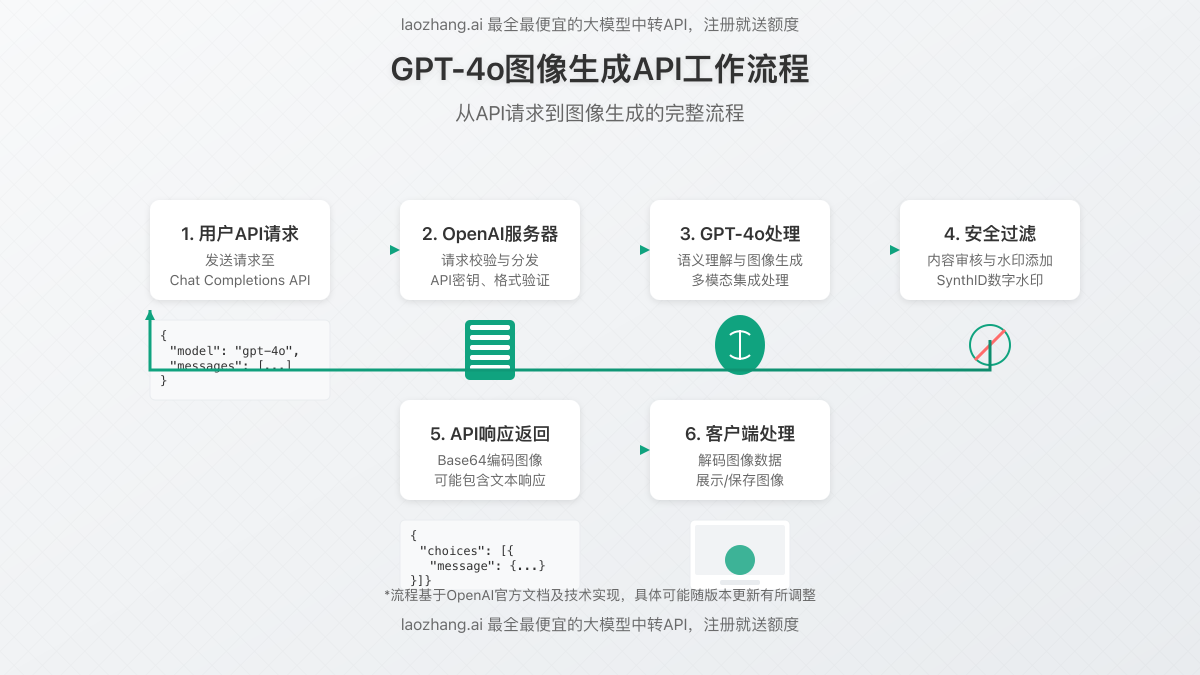
3. Cost Analysis and Pricing
Understanding the pricing structure is crucial for effectively budgeting your GPT-4o Image Generation API usage:
3.1 Official OpenAI Pricing
OpenAI has implemented a tiered pricing model for the GPT-4o Image Generation API based on resolution and quality settings:
| Resolution | Standard Quality | HD Quality |
|---|---|---|
| 1024×1024 px | $0.018 per image | $0.035 per image |
| 1536×1536 px | $0.035 per image | $0.070 per image |
| 2048×2048 px | $0.070 per image | $0.140 per image |
Additionally, OpenAI charges for the tokens used in the prompt, following the standard GPT-4o token pricing. For high-volume users, OpenAI offers enterprise plans with potential discounts based on usage commitments.
3.2 Cost-Effective Alternative: laozhang.ai API Bridge
For developers and businesses seeking a more economical solution, laozhang.ai offers a cost-effective API bridge service with several advantages:
- Reduced Pricing: Access GPT-4o Image Generation API at up to 30-40% lower cost than direct OpenAI pricing
- No Monthly Minimums: Pay only for what you use without OpenAI’s monthly spending requirements
- Simple Integration: Compatible API structure requiring minimal changes to existing OpenAI API implementations
- Free Trial Credits: New users receive complimentary credits upon registration
- Priority Access: Available immediately, even during OpenAI’s phased rollout period
To access GPT-4o through laozhang.ai’s API bridge service, simply register at api.laozhang.ai and replace the API endpoint in your requests:
curl https://api.laozhang.ai/v1/chat/completions \
-H "Content-Type: application/json" \
-H "Authorization: Bearer $API_KEY" \
-d '{
"model": "gpt-4o",
"messages": [
{"role": "system", "content": "You are a helpful assistant."},
{"role": "user", "content": "Generate an image of a mountain landscape at sunset."}
],
"modalities": ["image"]
}'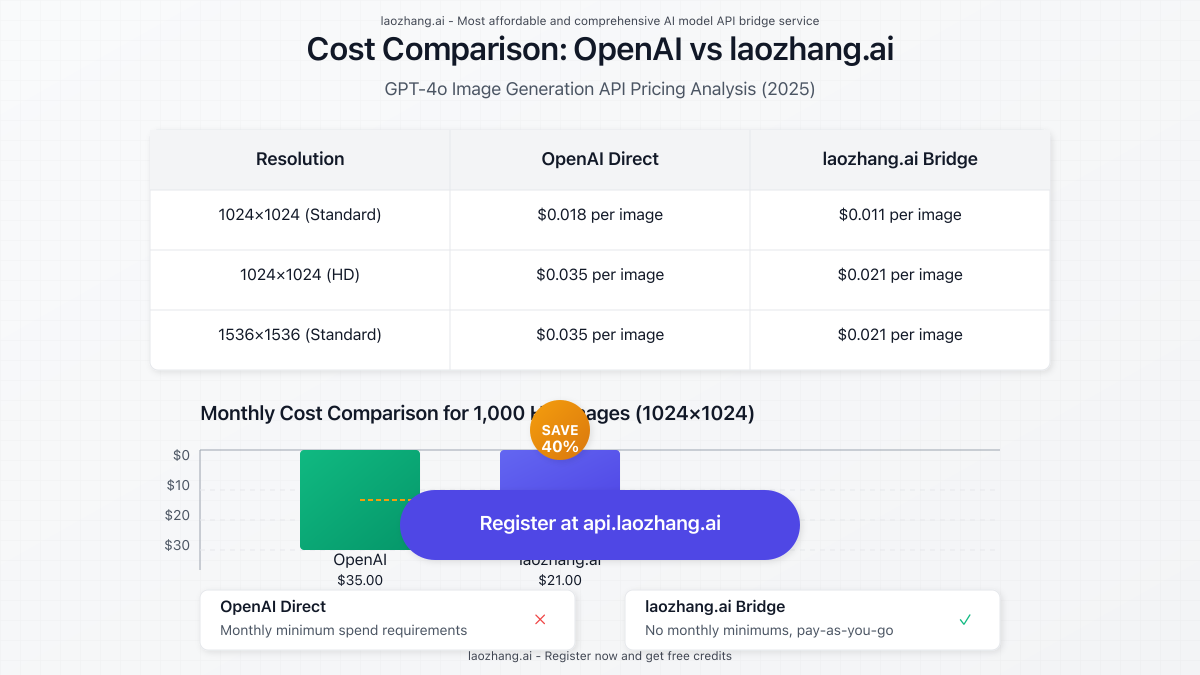
4. Advanced Features and Techniques
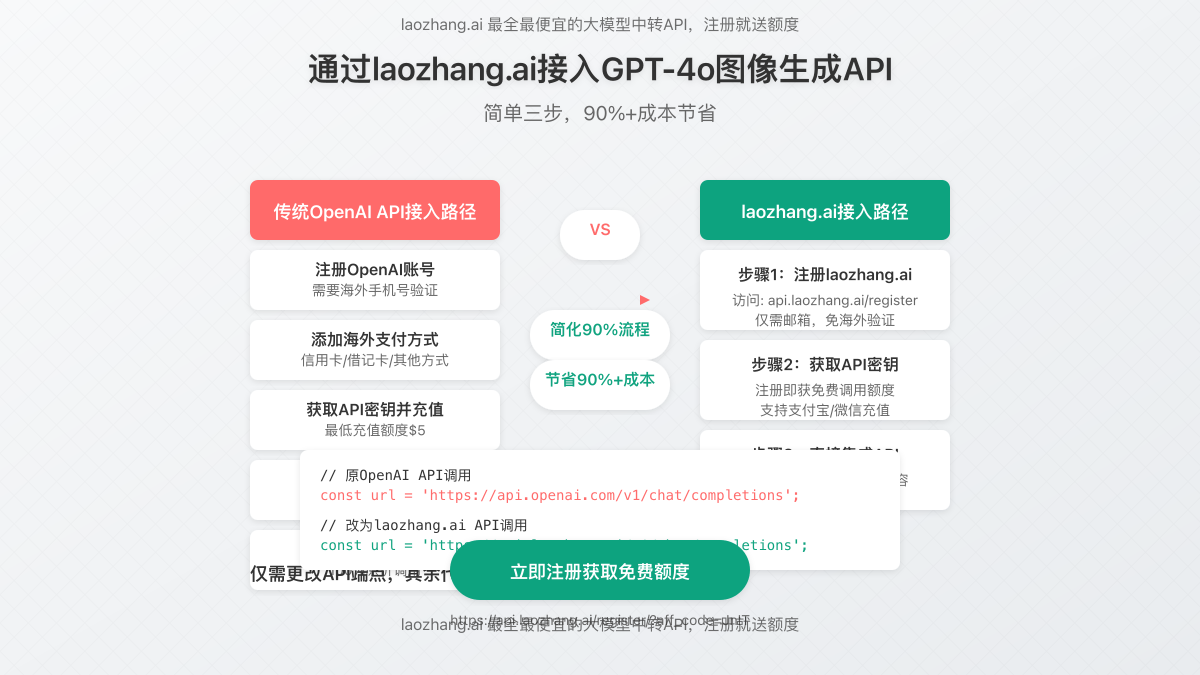
The GPT-4o Image Generation API offers several advanced capabilities that can be leveraged for creating more sophisticated and tailored images:
4.1 Style Control
While the API doesn’t have explicit style parameters, you can effectively control the visual style through detailed prompts. Include specific art styles, artists, or visual descriptors to guide the generation process:
"Generate an image in the style of impressionist painting depicting a countryside landscape with rolling hills and a small village."4.2 Detail Enhancement
For higher-quality images with more detailed elements, consider:
- Specifying “high-detail” or “photorealistic” in your prompts
- Using the HD quality option for more defined features
- Breaking down complex scenes into detailed descriptive elements
- Including specific lighting conditions (e.g., “golden hour lighting,” “soft diffused light”)
4.3 Composition Control
Guide the composition of your generated images by:
- Specifying camera angles (e.g., “aerial view,” “close-up,” “wide-angle”)
- Defining the focal point (e.g., “focusing on the central character”)
- Including depth indications (e.g., “with mountains in the background”)
- Describing the framing (e.g., “symmetrically composed,” “rule of thirds composition”)
4.4 Iterative Refinement
The contextual awareness of GPT-4o allows for iterative image creation through conversation:
- Generate an initial image with a basic prompt
- Provide feedback and request specific changes
- Continue refining through conversational iterations
# Initial request
"Generate an image of a modern office space."
# Refinement request
"Make the previous office space brighter with more natural light and add some plants."
# Further refinement
"Add a few people working collaboratively in the space and include some technology elements."5. Practical Applications and Use Cases
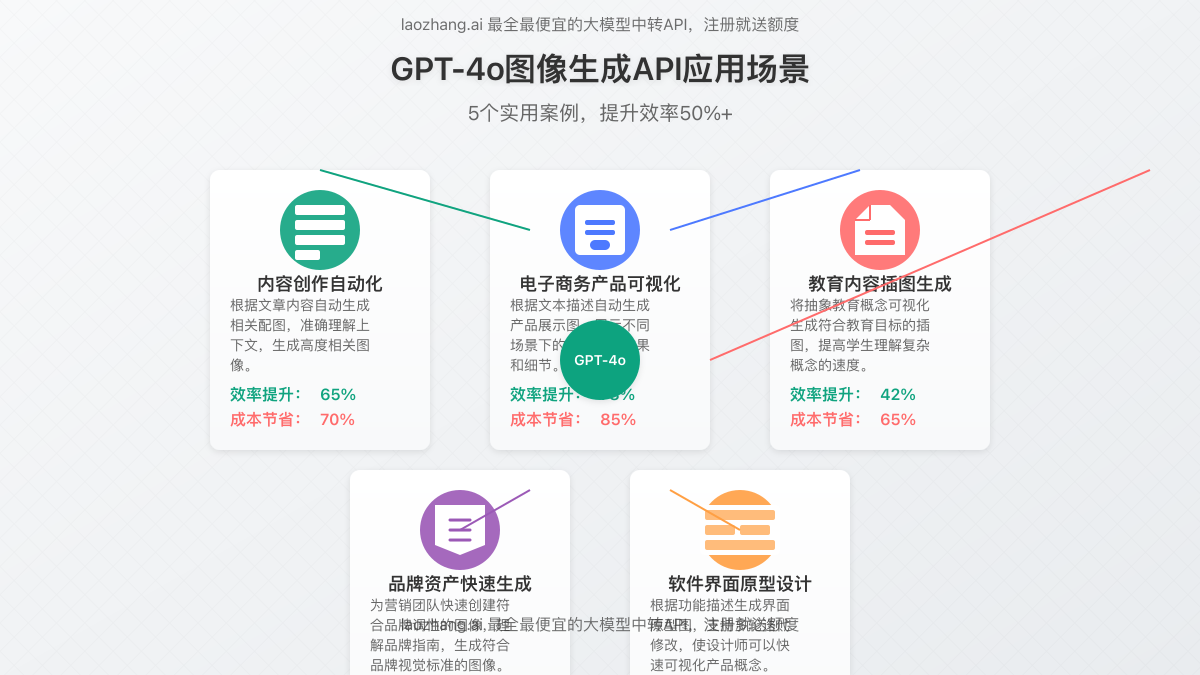
The GPT-4o Image Generation API enables a wide range of practical applications across various industries:
5.1 Marketing and Advertising
- Creating customized social media visuals and campaign assets
- Generating product mockups and concept visualizations
- Producing consistent brand imagery across multiple channels
- Developing visual A/B testing variations quickly
5.2 Education and Training
- Illustrating complex concepts with tailored visual aids
- Creating customized educational materials for different learning styles
- Developing interactive visual scenarios for training simulations
- Generating culturally appropriate imagery for global education materials
5.3 Product Design and Development
- Rapidly prototyping design concepts
- Visualizing user interfaces and experience flows
- Creating realistic product renderings for pre-production evaluation
- Generating variations of design elements for stakeholder feedback
5.4 Content Creation
- Producing illustrations for articles, blogs, and publications
- Creating consistent visual narratives for storytelling
- Generating custom thumbnails and featured images
- Developing visual content calendars with thematic consistency
5.5 Healthcare and Scientific Visualization
- Creating anatomical illustrations and medical concept visualizations
- Generating patient education materials with accurate visual references
- Visualizing scientific data and research concepts
- Producing consistent imagery for health campaigns
6. Best Practices and Optimization Tips
To achieve optimal results with the GPT-4o Image Generation API, consider these best practices:
6.1 Prompt Engineering
- Be Specific: Include detailed descriptions of elements, style, mood, and composition
- Use Visual References: Refer to known artistic styles or visual concepts
- Prioritize Elements: List the most important elements first in your prompt
- Avoid Negatives: Focus on what you want rather than what you don’t want
- Maintain Clarity: Use simple language and avoid ambiguous descriptions
6.2 Technical Optimization
- Batch Processing: Group similar image generation tasks when possible
- Resolution Selection: Choose appropriate resolutions based on the intended use case
- Error Handling: Implement robust retry mechanisms for API failures
- Caching Strategy: Consider caching frequently generated images to reduce API calls
- Rate Limiting: Implement client-side rate limiting to avoid API throttling
6.3 Cost Management
- Quality Tiering: Use standard quality for drafts and HD only when necessary
- Resolution Optimization: Select the smallest acceptable resolution for each use case
- Usage Monitoring: Track API usage patterns to identify optimization opportunities
- Alternative Services: Utilize laozhang.ai’s more affordable API bridge for high-volume needs
- Token Efficiency: Craft concise but effective prompts to minimize token usage
Expert Tips
- Start with simpler prompts and gradually add complexity through iterative refinement
- Use “high-quality image” as a prefix in your prompts to consistently improve results
- Specify “ensure the image has no text watermarks or logos” to reduce unwanted elements
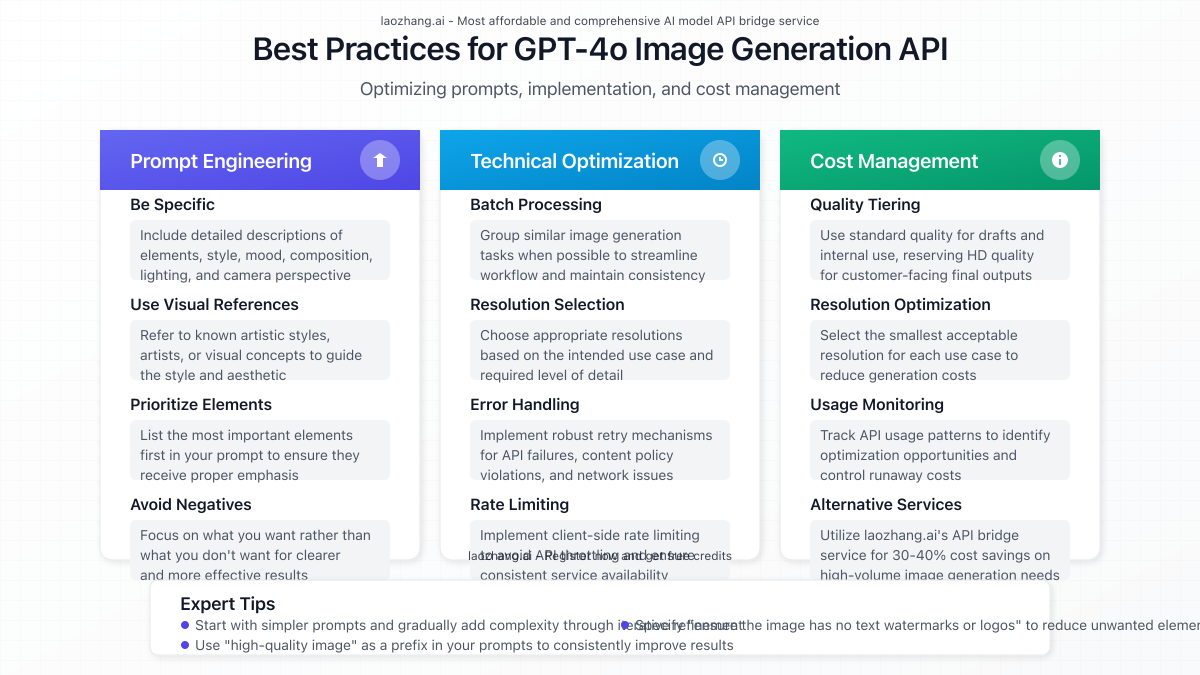
7. Limitations and Ethical Considerations
While the GPT-4o Image Generation API offers powerful capabilities, it’s important to be aware of its limitations and ethical implications:
7.1 Technical Limitations
- Text Rendering: While improved over previous models, complex text may still have minor inaccuracies
- Specific Details: Highly specific or unusual requests may not render exactly as described
- Consistency: Multiple generations of the same prompt may produce varying results
- Complex Scenes: Very complex scenes with multiple detailed elements may lose some fidelity
- API Availability: During high-demand periods, the API may experience latency or temporary unavailability
7.2 Ethical Guidelines
Responsible use of the GPT-4o Image Generation API involves adhering to these ethical principles:
- Content Policies: Comply with OpenAI’s content policies prohibiting harmful, deceptive, or illegal content generation
- Transparency: Clearly disclose when content is AI-generated in public-facing applications
- Privacy: Avoid generating images that could violate privacy rights or depict real individuals without consent
- Bias Awareness: Be mindful of potential biases in generated images and take steps to mitigate them
- Copyright Considerations: Understand the copyright implications of AI-generated images in your jurisdiction
7.3 Avoiding Content Policy Violations
To ensure your API usage remains compliant:
- Implement pre-screening for prompts that might violate content policies
- Use content moderation tools in conjunction with image generation
- Develop clear guidelines for acceptable use within your organization
- Regularly review and update your compliance measures as policies evolve
8. Future Developments and Roadmap
Based on OpenAI’s development patterns and industry trends, we can anticipate several future developments for the GPT-4o Image Generation API:
8.1 Expected Enhancements
- Increased Resolution Options: Support for even higher resolution outputs
- Advanced Editing Capabilities: More sophisticated image editing and manipulation functions
- Video Generation Integration: Potential extension into short video clip generation
- Enhanced Control Parameters: More explicit style and composition control options
- Improved Text Rendering: Further refinements in text accuracy and placement
8.2 Integration Possibilities
Future versions of the API may offer deeper integration with:
- 3D modeling and rendering workflows
- Augmented and virtual reality content creation
- Interactive design systems
- Real-time content generation platforms
Staying informed about these developments will help you maximize the potential of GPT-4o image generation capabilities in your applications.
9. Conclusion: Getting Started with GPT-4o Image Generation
The GPT-4o Image Generation API represents a significant advancement in AI-powered visual creation, offering developers unprecedented capabilities for generating high-quality, contextually relevant images. With its improved text rendering, prompt adherence, and knowledge integration, it opens new possibilities across numerous industries and use cases.
To begin leveraging this powerful technology:
- Register for API access through OpenAI or laozhang.ai’s more cost-effective bridge service
- Experiment with different prompt approaches to understand the model’s capabilities
- Start with simple implementations before scaling to more complex applications
- Monitor usage patterns and costs to optimize your implementation
- Stay informed about new features and best practices as the technology evolves
For cost-effective access to the GPT-4o Image Generation API with immediate availability and no monthly minimums, register at api.laozhang.ai. New users receive complimentary credits upon registration, allowing you to explore the capabilities without upfront investment. For personalized assistance, contact: ghj930213 on WeChat.
Next Steps
- Register for laozhang.ai API Access
- Explore the example code repository for implementation samples
- Join the developer community to share experiences and best practices
